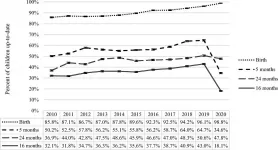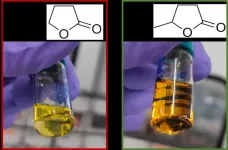(Press-News.org) HOUSTON -- The glutaminase (GLS1) inhibitor IACS-6274, discovered and developed by The University of Texas MD Anderson Cancer Center's Therapeutics Discovery division, appears to be well-tolerated with successful target inhibition and early signs of anti-tumor activity in a biomarker-driven Phase I trial. Interim results of the study will be presented at the 2021 American Society for Clinical Oncology (ASCO) Annual Meeting on June 4.
On the trial, 17 of 20 evaluable patients achieved a best response of stable disease, with a disease control rate of 60% at 12 weeks. Six patients with biomarker-defined advanced cancers had meaningful durable disease stabilization for greater than six months, with evidence of tumor shrinkage.
Comprehensive pharmacokinetics (PK) and pharmacodynamics (PD) analyses on serial tumor and/or blood samples from trial participants established a robust PK/PD relationship across dose levels. Using a clinical assay developed in-house to measure metabolic activity in patients' blood mononuclear cells, the team also observed strong inhibition of glutamine metabolism at the recommended Phase II dose level, suggesting IACS-6274 robustly functions as intended to block GLS1 activity.
This represents the first major clinical data reported by MD Anderson's Therapeutics Discovery division, a unique group of clinicians, researchers and drug development experts working collaboratively to advance impactful new therapies. By working seamlessly with MD Anderson physicians, the team gains unique clinical insights that aid in the development of impactful medicines.
"Within Therapeutics Discovery, we have focused our efforts to develop new therapies that meet the needs of our patients," said principal investigator Timothy A. Yap, M.B.B.S., Ph.D., associate professor of Investigational Cancer Therapeutics and medical director of the Institute for Applied Cancer Science (IACS). "Our comprehensive efforts to understand and advance IACS-6274 identified select groups of underserved patients as those most likely to benefit from treatment, and we are encouraged by the early results thus far in the study."
Developing a therapy for underserved patient groups
The development of IACS-6274, previously known as IPN60090, was led by a team of scientists and drug development experts in the IACS and Translational Research to Advance Therapeutics and Innovation in Oncology (TRACTION) platforms, both engines within Therapeutics Discovery.
IACS-6274 was selected for development based on its potency, selectivity and PK profile to provide sustained GLS-1 inhibition in patients. The research team then conducted patient-driven translational studies to identify unique populations of patients likely to respond.
Based on these studies, priority indications for the trial include non-small cell lung cancers (NSCLC) with KEAP1/NFEL2L2 mutations, ovarian cancers with low expression of asparagine synthetase (ASNS) and tumors with immune checkpoint inhibitor resistance. Additional insights have revealed that cancers with STK11 and NF1 mutations may respond to GLS1 inhibitors, so the trial also has enrolled those patients.
Evaluating IACS-6274 in a Phase I clinical trial
The first-in-human dose-escalation study was conducted by MD Anderson's Phase I Clinical Trials Program in the Department of Investigational Cancer Therapeutics. The study was designed to evaluate the safety and tolerability of IACS-6274, to identify the maximum tolerated dose and to establish a recommended Phase II dose. Secondary objectives included PK, PD, anti-tumor activity and correlation of biomarkers with clinical outcomes.
The study has enrolled 22 patients with a median age of 63.5, all of whom had received at least two prior therapies. Sixteen patients (73%) are female and six (27%) are male. The trial included patients with different tumor and molecular subtypes, including many of the identified priority patient populations.
The six patients with durable stable disease included those with advanced ASNS-low ovarian cancer, melanoma resistant to anti-PD-1 therapies, NF1-mutant leiomyosarcoma and STK11-mutant NSCLC.
The most common side effects were mild transient visual disturbances. Less common grade 3 toxicities at higher dose levels included reversible nausea, vomiting and fatigue. One patient experienced dose-limiting acute renal failure and posterior reversible encephalopathy syndrome (PRES) at the highest dose level, which fully resolved.
"IACS-6274 appears to be safe and well-tolerated at our recommended Phase II dose, with early signs of anti-tumor activity in patients with certain molecular features," Yap said. "As the study progresses and we continue to learn from those participating, we will work to explore rational combination therapies that are predicted to maximize the benefits for distinct groups of patients based on key biomarkers of response."
INFORMATION:
A full list of collaborating authors and their disclosures can be found with the abstract.
ABSTRACT #3001
URBANA, Ill. - Women's ability to work as entrepreneurs can help alleviate poverty and malnutrition in developing countries. As local governments and development organizations aim to encourage business opportunities, it's important to identify projects suited for women's lives in rural households.
The soy kit, which includes common household items such as a pot, spoon, thermometer, and cheese cloth, enables entrepreneurs to create value-added products from soy in small-scale household settings. The kit has potential to improve the economic conditions of Malawi women in a sustainable way, a University of Illinois study concludes.
"The larger issue is about adding value to agricultural products in the developing world as a means ...
Boulder, Colo., USA: The Paleozoic era culminated 251.9 million years ago in the most severe mass extinction recorded in the geologic record. Known as the "great dying," this event saw the loss of up to 96% of all marine species and around 70% of terrestrial species, including plants and insects.
The consensus view of scientists is that volcanic activity at the end of the Permian period, associated with the Siberian Traps Large Igneous Province, emitted massive quantities of greenhouse gases into the atmosphere over a short time interval. This caused a spike in global temperatures and a cascade of other deleterious ...
Keto, gluten-free, organic: If a pet owner is on a specific diet, chances are their dog is on it, too, a new U of G study reveals.
But when it comes to a grain-free diet, owners seem to choose it more for their dogs than themselves, the study also found.
"It demonstrates that many variables, not just dietary habits, influence the selection of dog food," said study lead author Sydney Banton, a master's student in U of G's Department of Animal Biosciences.
The international Pet Food Consumer Habit Survey is the first of its kind to examine factors involved in ...
NEWPORT, Ore. - The population of white sharks that call the Central California coast their primary home is holding steady at about 300 animals and shows some signs of growth, a new long-term study of the species has shown.
Between 2011 and 2018, researchers were able to identify hundreds of individual adult and subadult white sharks, which are not fully mature but are old enough to prey on marine mammals. They used that information to develop estimates of the sharks' abundance.
"The finding, a result of eight years of photographing and identifying individual ...
In new research, Texas A&M University scientists have for the first time revealed a single microscopic defect called a "twin" in a soft-block copolymer using an advanced electron microscopy technique. This defect may be exploited in the future to create materials with novel acoustic and photonic properties.
"This defect is like a black swan -- something special going on that isn't typical," said Dr. Edwin Thomas, professor in the Department of Materials Science and Engineering. "Although we chose a certain polymer for our study, I think the twin defect will be fairly universal across a bunch of similar soft matter systems, like oils, surfactants, biological materials and natural polymers. Therefore, our findings will be valuable to diverse research across the soft matter field."
The ...
Scanning technology aimed at detecting small amounts of nuclear materials was unveiled by scientists in Sweden today, with the hope of preventing acts of nuclear terrorism.
Bo Cederwall, a professor of physics at KTH Royal Institute of Technology, says the technology can be used in airports and seaports for routine inspection of passengers and goods. The research is published and featured in the journals Science Advances and Science, respectively.
A form of tomography, the system enables quick 3D imaging of the source of neutron and gamma ray emissions from weapons-grade plutonium and other special nuclear materials, Cederwall says.
The so-called Neutron-Gamma Emission Tomography (NGET) system goes beyond the capabilities of existing radiation portal monitors, ...
Despite expert recommendations that children continue to get regularly scheduled vaccines during the pandemic, vaccination rates have decreased in several states.
A new study by researchers from the Texas A&M University School of Public Health and several other research institutions looked at childhood immunization rates in Texas to see what effect the COVID-19 pandemic may have had on childhood immunizations in 2020. In the study, led by public health doctoral student Tasmiah Nuzhath and published in the journal Vaccine, the researchers used data from a statewide immunization registry ...
May 19, 2021 - For patients with severe arthritis of the ankle, total ankle arthroplasty (TAA) provides better long-term function than ankle arthrodesis (AA), reports a study in The Journal of Bone & Joint Surgery. The journal is published in the Lippincott portfolio in partnership with Wolters Kluwer.
"Both established treatments for end-stage ankle arthritis are effective at pain relief and improved patient-reported outcomes," according to the research by Bruce Sangeorzan MD, and colleagues at the University of Washington and VA Puget Sound Health Care System. "However, it appears TAA leads to greater improvement in most patient-reported outcome measures at 48 months after surgery."
Study adds to evidence supporting TAA for ankle arthritis
End-stage ankle arthritis is characterized ...
The continued growth of wireless and cellular data traffic relies heavily on light waves. Microwave photonics is the field of technology that is dedicated to the distribution and processing of electrical information signals using optical means. Compared with traditional solutions based on electronics alone, microwave photonic systems can handle massive amounts of data. Therefore, microwave photonics has become increasingly important as part of 5G cellular networks and beyond. A primary task of microwave photonics is the realization of narrowband filters: the selection of specific data, at specific frequencies, out of immense volumes that are carried over light.
Many microwave photonic systems are built ...
Scientists at SPECIFIC Innovation and Knowledge Centre, Swansea University, have found a way to replace the toxic, unsustainable solvents currently needed to make the next generation of solar technology.
Printed carbon perovskite solar cells have been described as a likely front runner to the market because they are extremely efficient at converting light to electricity, cheap and easy to make.
A major barrier to the large-scale manufacture and commercialisation of these cells is the solvents used to control crystallisation of the perovskite during fabrication: this is because they are ...







